Tacheocampylaea Korsika
© Alessandro Margelli & Clemens M. Brandstetter
Tacheocampylaea L. Pfeiffer 1877
Die Arten Korsikas:
Tacheocampylaea raspailii (Payraudeau 1827)
 Escargot de Raspail
Escargot de Raspail
 Falkner & al. 2011c: The name has until recently been used for all Corsican species of Tacheocampylaea (for which 27 names have been published). Thus, literature has to be carefully monitored, to understand which species is actually meant. The species has been reported from a total of 35 sites. Recently, the presence of living specimens could be confirmed only in eight sites. The comparison with historical collections shows that the number of individuals in reproducing populations is also decreasing. This species is assessed as Vulnerable (VU) B1ab (i,ii,iii,iv,v)+2ab (i,ii,iii,iv,v). This species is endemic to Corsica where it is confined to the younger northeastern part which is known as the Alpine Corsica; the northernmost locality is San Martino di Lota on the peninsula of Cap Corse and the southernmost is in the plain of Aleria. Most known localities are concentrated between St. Florent (type locality) and Bastia; a second less densely populated centre is the Castagniccia. There are no data on the population size (usually low individual numbers), but it is assumed to be decreasing, the number of subpopulations is also decreasing. The comparison with historical collections shows that even the number of individuals in reproducing populations is decreasing. In July 1990, on the type locality 64, partly fresh empty shells were found by Graack (1996), but later, Ripken (1995, 1996) could not find living specimens (Falkner pers. comm. 2011). A remarkably thriving population could be observed in 2000 on an old stone wall in the town of Pietrabugno (Falkner pers. comm. 2011). Usually, this species inhabits wooded rocky slopes and boulder scree. As a secondary habitat, old stone walls with cavities may be colonised. Potential threats to this species are destruction of the habitats by urbanisation, tourism and recreational development, road construction, deforestation, and fire; a major threat is predation by pigs living in the wild. This species is protected by law. According to the taxonomic view of the late 20th century, all Tacheocampylaea species of Corsica have been lumped together under the name T. raspailii and were incorporated under that name in the „Liste des mollusques protégés sur l’ensemble du territoire“ (Journal officiel de la Republique Française N. C. 3953 du 12 Mai 1979; this taxonomic view seems to have been perpetuated in the last update of the legislation from 2007 (www.conservation-nature.fr).
Falkner & al. 2011c: The name has until recently been used for all Corsican species of Tacheocampylaea (for which 27 names have been published). Thus, literature has to be carefully monitored, to understand which species is actually meant. The species has been reported from a total of 35 sites. Recently, the presence of living specimens could be confirmed only in eight sites. The comparison with historical collections shows that the number of individuals in reproducing populations is also decreasing. This species is assessed as Vulnerable (VU) B1ab (i,ii,iii,iv,v)+2ab (i,ii,iii,iv,v). This species is endemic to Corsica where it is confined to the younger northeastern part which is known as the Alpine Corsica; the northernmost locality is San Martino di Lota on the peninsula of Cap Corse and the southernmost is in the plain of Aleria. Most known localities are concentrated between St. Florent (type locality) and Bastia; a second less densely populated centre is the Castagniccia. There are no data on the population size (usually low individual numbers), but it is assumed to be decreasing, the number of subpopulations is also decreasing. The comparison with historical collections shows that even the number of individuals in reproducing populations is decreasing. In July 1990, on the type locality 64, partly fresh empty shells were found by Graack (1996), but later, Ripken (1995, 1996) could not find living specimens (Falkner pers. comm. 2011). A remarkably thriving population could be observed in 2000 on an old stone wall in the town of Pietrabugno (Falkner pers. comm. 2011). Usually, this species inhabits wooded rocky slopes and boulder scree. As a secondary habitat, old stone walls with cavities may be colonised. Potential threats to this species are destruction of the habitats by urbanisation, tourism and recreational development, road construction, deforestation, and fire; a major threat is predation by pigs living in the wild. This species is protected by law. According to the taxonomic view of the late 20th century, all Tacheocampylaea species of Corsica have been lumped together under the name T. raspailii and were incorporated under that name in the „Liste des mollusques protégés sur l’ensemble du territoire“ (Journal officiel de la Republique Française N. C. 3953 du 12 Mai 1979; this taxonomic view seems to have been perpetuated in the last update of the legislation from 2007 (www.conservation-nature.fr).
By Cardioceras (Own work) [CC-BY-3.0], via Wikimedia Commons
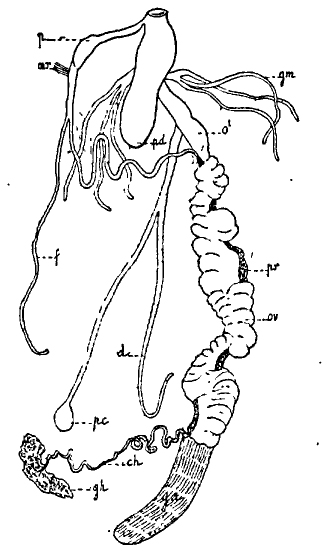
Die Genitalarmaturen aus Germain (1930).
Tacheocampylaea cyrniaca (Dutailly 1867)
 Hélice du Monte Rotondo
Hélice du Monte Rotondo
 Falkner & al. 2011f: There are four subspecies currently accepted: Tacheocampylaea cyrniaca cyrniaca, T. cyrniaca omphalophora, T. cyrniaca faucicola and T. cyrniaca arusalensis.Tacheocampylaea revelierii (Debeaux, 1867) [Helix] is a synonym to this species. In 2009, a fourth subspecies, T. c. arusalensis (Hagenmüller, 1888) – up to now forgotten – was found back near its type locality by G. Falkner, C. Régnier and B. Recorbet.
Falkner & al. 2011f: There are four subspecies currently accepted: Tacheocampylaea cyrniaca cyrniaca, T. cyrniaca omphalophora, T. cyrniaca faucicola and T. cyrniaca arusalensis.Tacheocampylaea revelierii (Debeaux, 1867) [Helix] is a synonym to this species. In 2009, a fourth subspecies, T. c. arusalensis (Hagenmüller, 1888) – up to now forgotten – was found back near its type locality by G. Falkner, C. Régnier and B. Recorbet.
The species (comprising four subspecies) is confined to a rather small part of central Corsica, where it has been reported from a total of 18 sites and 10 locations. Investigations during the last 15 years have shown that nearly 50% of the known populations can not be confirmed anymore. Especially in the Restonica valley the decline is evident. Therefore, this species is assessed as Endangered (EN) B1ab (i,ii,iii,iv,v)+2ab(i,ii,iii,iv,v). It should be noted that the 18 sites concern all four subspecies, this means that each subspecies has less than five locations. The species is known from 18 localities in Corsica, 10 of them being reconfirmed in the last two decades with an extent of occurrence of around 800 km2 and area of occupancy of 40 km2. The species agg. is endemic to central Corsica.
The four subspecies are disjointed in four montains areas:
Tacheocampylaea cyrniaca cyrniaca (Dutailly 1867)
 Falkner & al. 2011f: Monte Renoso massif, up to 2,300-2,350 m (loc. typ.), actually two populations have been discovered by B. Recorbet at 1,450 m (Val d’Ese) and 1,950 m (Crête de Scaldasole).
Falkner & al. 2011f: Monte Renoso massif, up to 2,300-2,350 m (loc. typ.), actually two populations have been discovered by B. Recorbet at 1,450 m (Val d’Ese) and 1,950 m (Crête de Scaldasole).
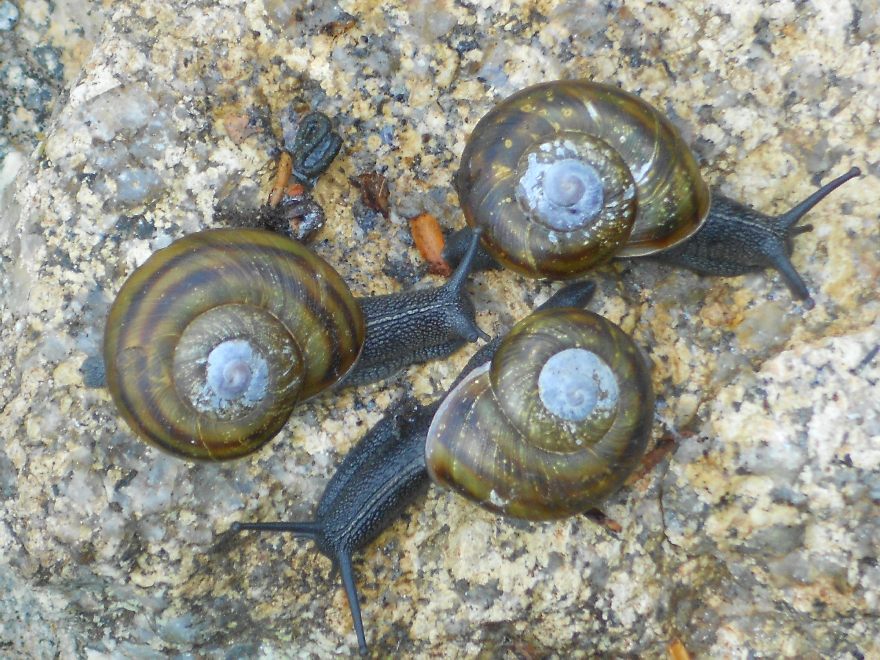
Valle d’Ese unter einem Felsblock – Foto: Antonio Busetto & Paolo Marenzi.
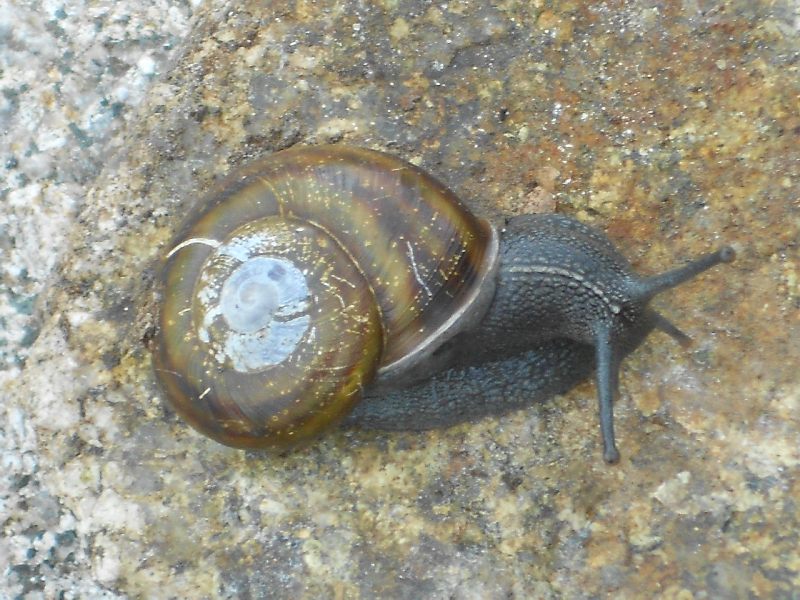
Einzeltier – Foto: Antonio Busetto & Paolo Marenzi.
Tacheocampylaea cyrniaca omphalophora (Dutailly 1867)
 Falkner & al. 2011f: Monte Rotondo massif, up to 2,650 m and down to the region of Corte (loc. typ.), actually known in three sparse populations in the Restonica valley between 470 m and 1,080 m (Ripken and Falkner), which have recently been affected by a heavy forest fire.
Falkner & al. 2011f: Monte Rotondo massif, up to 2,650 m and down to the region of Corte (loc. typ.), actually known in three sparse populations in the Restonica valley between 470 m and 1,080 m (Ripken and Falkner), which have recently been affected by a heavy forest fire.
Tacheocampylaea cyrniaca faucicola (Hagenmüller 1888)
 Falkner & al. 2011f: Foce – Col de Vizzavona, 1,200-1,400 m (loc. typ.) and Monte d’Oro, actually known from Col de Vizzavona below the ancient fort at 1,190 m (Falkner and Régnier), Forêt de Vizzavona, and Monte d’Oro 2,040 m (B. Recorbet).
Falkner & al. 2011f: Foce – Col de Vizzavona, 1,200-1,400 m (loc. typ.) and Monte d’Oro, actually known from Col de Vizzavona below the ancient fort at 1,190 m (Falkner and Régnier), Forêt de Vizzavona, and Monte d’Oro 2,040 m (B. Recorbet).
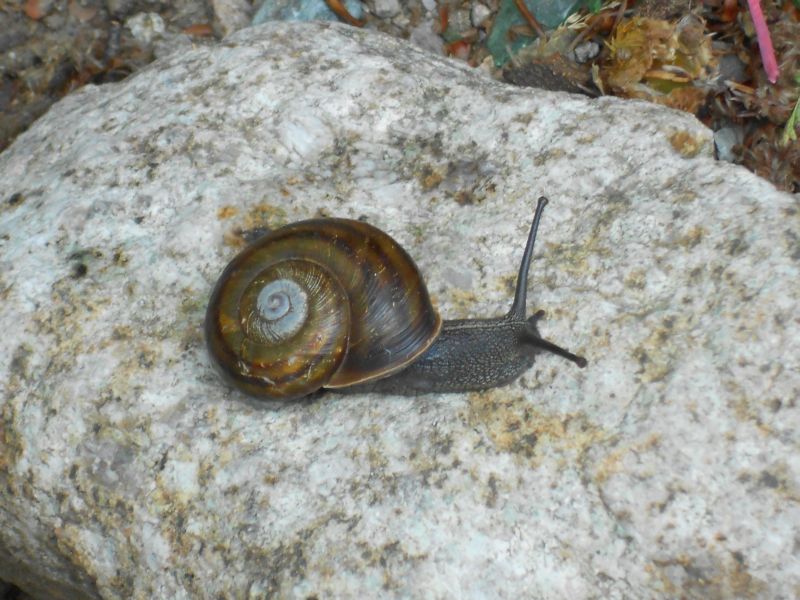
Foto: Antonio Busetto & Paolo Marenzi.
Tacheocampylaea cyrniaca arusalensis (Hagenmüller 1888)
 Falkner & al. 2011f: Col d’Arusala au pied de Manteluccio (loc. typ.), actually rediscovered at Calderamolla north of Col d’Arusula (Falkner, Regnier and Recorbet).
Falkner & al. 2011f: Col d’Arusala au pied de Manteluccio (loc. typ.), actually rediscovered at Calderamolla north of Col d’Arusula (Falkner, Regnier and Recorbet).
Tacheocampylaea acropachia (J. Mabille 1880)
 Falkner & al. 2011a: This is a polytypic species with two subspecies besides the nominotypical subspecies: T. acropachia pollonerae (Caziot, 1903) and T. acropachia garciai (Hagenmüller, 1888). According to recent research (Falkner ined.) the populations in the north-west of the total distribution area adjacent to the Monte Cardo, which have been described as Helix (Campylaea) venacensis Caziot, 1903, form a well characterised distinct species which has wrongly been treated as a synonym of T. a. acropachia. The species is endemic to Corsica where there are six known locations. The extent of occurrence is 250 km2 and the area of occupancy is 24 km2. Investigations during the last 15 years have shown that about 50% of the known populations can no longer be reconfirmed. On the two sides of the Col de Sorba the complete loss of three known populations caused by forest fire could be observed in 2000. Therefore, this species is assessed as Endangered (EN) B1ab (i,ii,iii,iv,v) + 2ab (i,ii,iii,iv,v). It should be noted that the six locations concern three different subspecies. T. acropachia agg. is the Corsican Tacheocampylaea species with the largest distribution area in the Ancient Corsica. It reaches from the region of Vezzani in the North to the Montagne de Cagna (type locality of acropachia s. str.) and Bonifacio in the South; in the West it has been found at Sartène. There is no information on the size of the sub-populations. However, the trend is decreasing; the species agg. (including all three subspecies) is known from 22 sites of which eight could be reconfirmed during the last two decades. All Tacheocampylaea species have a strictly nocturnal activity; therefore it is nearly impossible to follow up the population trend, but in comparison to historical material, a considerable general decline can be deduced. The major threat to this species is local wild-fire. The complete destruction of at least three populations by forest fire raising could be documented in 2000 (personal observation of G. and M. Falkner). Possibly the species is legally protected under the former taxonomic perception of all Corsican Tacheocampylaea as a single species, which has been inscribed in the national list of protected species under the name Tacheocampylaea raspailii (see that species). Measures that might help to prevent wild-fires like closing the area for recreational (picnic), or related touristic activities like hiking, biking, wild camping etc. should be encouraged. Probably the remaining sites should be closed down completely from public access.
Falkner & al. 2011a: This is a polytypic species with two subspecies besides the nominotypical subspecies: T. acropachia pollonerae (Caziot, 1903) and T. acropachia garciai (Hagenmüller, 1888). According to recent research (Falkner ined.) the populations in the north-west of the total distribution area adjacent to the Monte Cardo, which have been described as Helix (Campylaea) venacensis Caziot, 1903, form a well characterised distinct species which has wrongly been treated as a synonym of T. a. acropachia. The species is endemic to Corsica where there are six known locations. The extent of occurrence is 250 km2 and the area of occupancy is 24 km2. Investigations during the last 15 years have shown that about 50% of the known populations can no longer be reconfirmed. On the two sides of the Col de Sorba the complete loss of three known populations caused by forest fire could be observed in 2000. Therefore, this species is assessed as Endangered (EN) B1ab (i,ii,iii,iv,v) + 2ab (i,ii,iii,iv,v). It should be noted that the six locations concern three different subspecies. T. acropachia agg. is the Corsican Tacheocampylaea species with the largest distribution area in the Ancient Corsica. It reaches from the region of Vezzani in the North to the Montagne de Cagna (type locality of acropachia s. str.) and Bonifacio in the South; in the West it has been found at Sartène. There is no information on the size of the sub-populations. However, the trend is decreasing; the species agg. (including all three subspecies) is known from 22 sites of which eight could be reconfirmed during the last two decades. All Tacheocampylaea species have a strictly nocturnal activity; therefore it is nearly impossible to follow up the population trend, but in comparison to historical material, a considerable general decline can be deduced. The major threat to this species is local wild-fire. The complete destruction of at least three populations by forest fire raising could be documented in 2000 (personal observation of G. and M. Falkner). Possibly the species is legally protected under the former taxonomic perception of all Corsican Tacheocampylaea as a single species, which has been inscribed in the national list of protected species under the name Tacheocampylaea raspailii (see that species). Measures that might help to prevent wild-fires like closing the area for recreational (picnic), or related touristic activities like hiking, biking, wild camping etc. should be encouraged. Probably the remaining sites should be closed down completely from public access.
Tacheocampylaea acropachia acropachia (J. Mabille 1880)
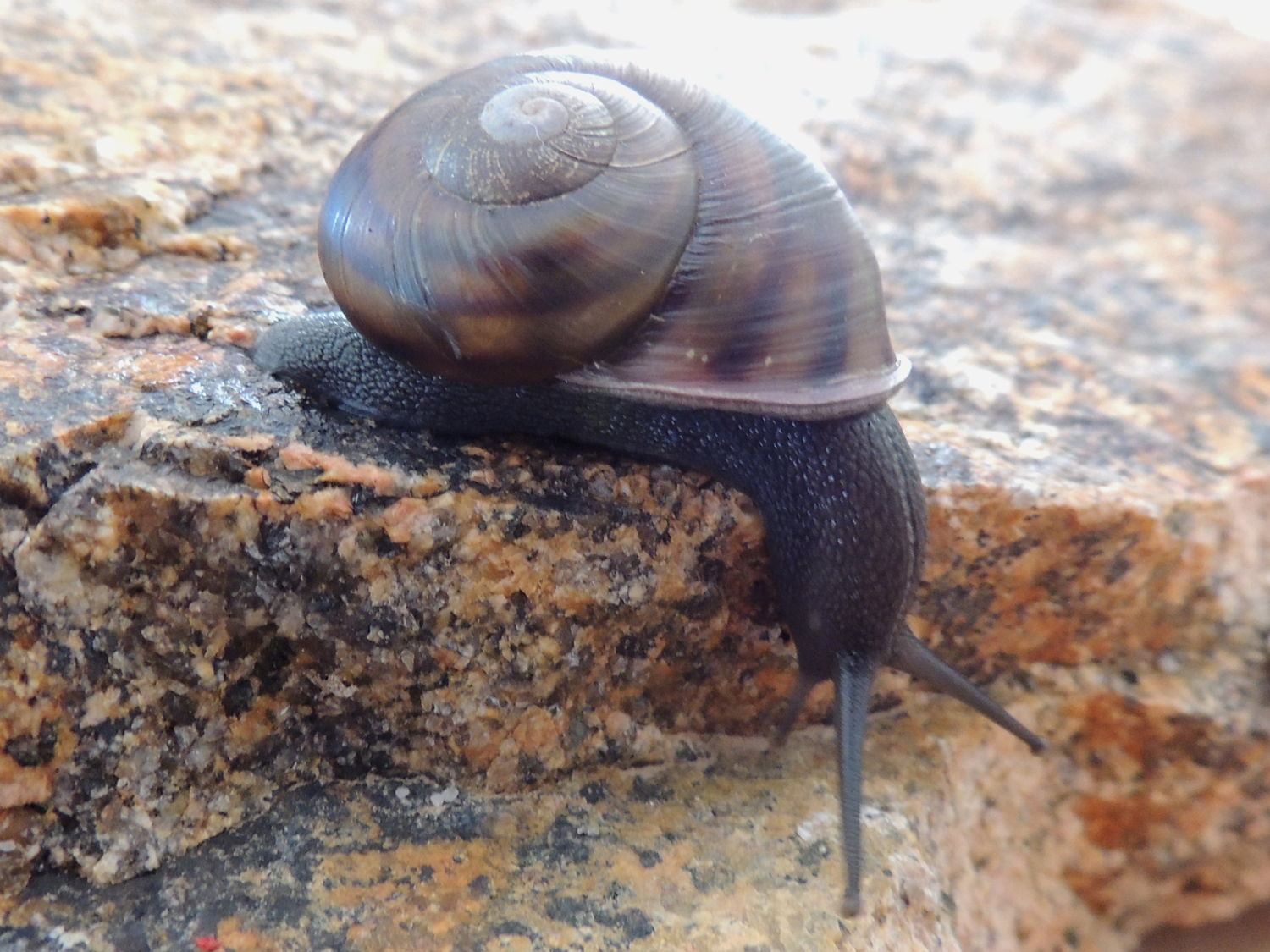
Nach 130 Jahren von Falkner & Brandstetter am Locus typicus wiederentdeckt – Foto: C.M.Brandstetter.
Tacheocampylaea acropachia pollonerae (Caziot 1888)
Tacheocampylaea acropachia garciai (Hagenmüller 1888)
Ein Exemplar, gefunden von Bernard Recorbet, am Col di verde. Die Unterart wurde vom Monte Incudine beschrieben – Foto: C.M.Brandstetter.
Tacheocampylaea venacensis (Caziot 1903)
Anlässlich einer Forschungsreise der Ersten Vorarlberger Malakologischen Gesellschaft im Herbst 2014 nach Korsika konnten Gerhard Falkner, Wolfgang und Clemens M. Brandstetter die verschollene „gute“ Art wieder entdecken. Falkner (mdl. Mitt.) betonte, dass im vorigen Text der IUCN zu wenig herausgestrichen wurde, dass T. venacensis eine von T. acropachia sehr gut unterscheidbare Art sei.
Falkner, Brandstetter & Brandstetter haben die Art wieder entdeckt – Foto: C.M.Brandstetter
Tacheocampylaea romagnolii (Dutailly 1867)
 Falkner & al. 2011d: This is a polytypic species with two subspecies: T. romagnolii romagnolii (Dutailly, 1867), and T. r. deschampsiana (Hagenmüller, 1888). This species is known only from one location (= 4 km2 in IUCN standards), however, the inferred actual area of occupancy (AOO) for this species 0.6 km2. The species (with two subspecies) is endemic to a very restricted area in the west and north of Corte. The nominal subspecies is probably extinct. Of the five localities where the subspecies T. r. deschampsiana was known, only one surviving subpopulation is left and is facing pressure from human activities. This dramatic decline leads to the assessment as Critically Endangered (CR) B1ab (iii,v) + 2ab (iii,v). The information on the distribution of the nominotypical subspecies T. r. romagnolii is confusing: The type locality is originally indicated as „… aux environs de Corte“ (Dutailly 1867). Hagenmüller (1888) did search the species thoroughly, but unsuccessfully, in the surroundings of Corte. However an occurrence in the Tavignano valley near Corte is indicated by Scharff (1894). A former occurrence in the Orta valley, as indicated by Germain (1931), seems possible. The largest part of the existing museum material was collected and distributed by the entomologist Revelière. As Revelière kept his collection site secret, his residence Bonifacio is often erroneously indicated as the locality. This species inhabits rocky habitats in primary Mediterranean woodlands.
Falkner & al. 2011d: This is a polytypic species with two subspecies: T. romagnolii romagnolii (Dutailly, 1867), and T. r. deschampsiana (Hagenmüller, 1888). This species is known only from one location (= 4 km2 in IUCN standards), however, the inferred actual area of occupancy (AOO) for this species 0.6 km2. The species (with two subspecies) is endemic to a very restricted area in the west and north of Corte. The nominal subspecies is probably extinct. Of the five localities where the subspecies T. r. deschampsiana was known, only one surviving subpopulation is left and is facing pressure from human activities. This dramatic decline leads to the assessment as Critically Endangered (CR) B1ab (iii,v) + 2ab (iii,v). The information on the distribution of the nominotypical subspecies T. r. romagnolii is confusing: The type locality is originally indicated as „… aux environs de Corte“ (Dutailly 1867). Hagenmüller (1888) did search the species thoroughly, but unsuccessfully, in the surroundings of Corte. However an occurrence in the Tavignano valley near Corte is indicated by Scharff (1894). A former occurrence in the Orta valley, as indicated by Germain (1931), seems possible. The largest part of the existing museum material was collected and distributed by the entomologist Revelière. As Revelière kept his collection site secret, his residence Bonifacio is often erroneously indicated as the locality. This species inhabits rocky habitats in primary Mediterranean woodlands.
Tacheocampylaea romagnolii romagnolii (Dutailly 1867)
 Hélice de Corte
Hélice de Corte
 Falkner & al. 2011d: There is no information available on the population size or trend of this species, the nominotypical subspecies Tacheocampylaea romagnolii romagnolii is probably gone extinct already.
Falkner & al. 2011d: There is no information available on the population size or trend of this species, the nominotypical subspecies Tacheocampylaea romagnolii romagnolii is probably gone extinct already.
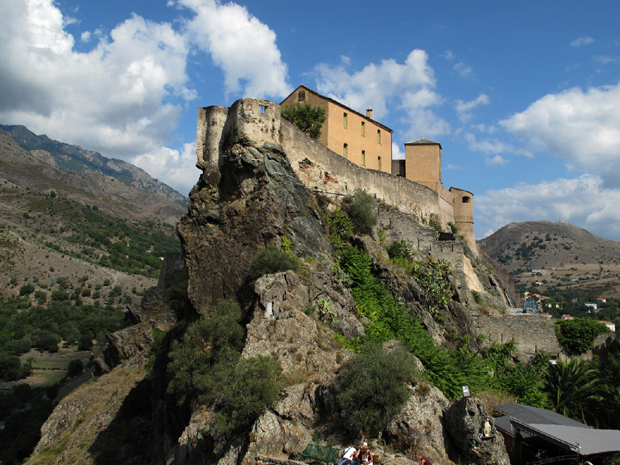
Die Zitadelle von Corte – ein (ehemaliger?) Fundort – Foto: Christiane Kummler.
Tacheocampylaea romagnolii deschampsiana (Hagenmüller 1888)
 Hélice de la Tartagine
Hélice de la Tartagine
 Falkner & al. 2011d: [note: the subspecies does not occur in the Tartagine valley as could be presumed from the common name].
Falkner & al. 2011d: [note: the subspecies does not occur in the Tartagine valley as could be presumed from the common name].
 Falkner & al. 2011: Collection samples indicate that the subspecies T. r. deschampsiana had a larger distribution in the Tavignano valley and its sourroundings west of Corte; in 2004 the T. r. deschampsiana was only found living in the Forêt de Melo.
Falkner & al. 2011: Collection samples indicate that the subspecies T. r. deschampsiana had a larger distribution in the Tavignano valley and its sourroundings west of Corte; in 2004 the T. r. deschampsiana was only found living in the Forêt de Melo.
In örtlichen Publikationen (Delmas 2012) finden wir eine Zusammenfassung der in Corte vorkommenden Tierarten, deren Präsenz durch Publikationen oder Berichte bestätigt wurde.

Die behaarte T. r. deschampsiana – Foto: Antonio Busetto & Paolo Marenzi.
Wir sind schon gespannt zu welcher ssp. die Tiere aus dem Gebiet um Evisa gestellt werden:
In den Wäldern um Evisa wurden Leerschalen gefunden – leg. O. Gargominy.
Aus dem Gebiet der Tartagine stammt ein Lebend-Exemplar:
Ebenfalls ein Waldtier aus der Umgebung von Olmi Cappella – leg. O. Gargominy.
 Link zu den Arten der Insel Sardinien
Link zu den Arten der Insel Sardinien
 Link zu den Arten der Insel Capraia
Link zu den Arten der Insel Capraia
Link zur Seite Allgemein, Gefährdung, Schutz, Literatur hier klicken

